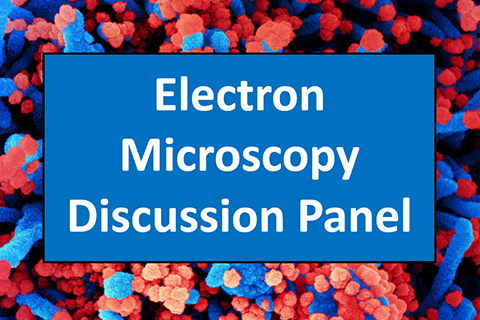The Scientific Library recently hosted a discussion panel on electron microscopy services at the National Cancer Institute (NCI) at Frederick and Frederick National Laboratory for Cancer Research (FNL), its third panel of 2020.
The series is one of the Scientific Library’s latest efforts to use its position as a research information hub to foster scientific interaction, collaboration, and discussion. Previous panels featured staff from Advanced Biomedical Computational Science, who spoke about data science, and staff from Scientific Publications, Graphics, and Media, who spoke about the scientific publishing process.
The Electron Microscopy Discussion Panel brought together specialists Natalia De Val Alda, Ph.D., director of the Electron Microscopy Laboratory (EML) and the Center for Molecular Microscopy (CMM) at FNL; Kunio Nagashima, manager of EML; Htet Khant, a scientist at CMM; and Thomas Edwards, Ph.D., a microscopist at the FNL National Cryo-Electron Microscopy Facility (NCEF).
Availability and Apparatus
The panelists began by describing their facilities’ services and availability. Edwards said NCEF serves the extramural community of cancer researchers by providing high-end imaging, primarily single-particle electron tomography.
De Val Alda, meanwhile, explained that CMM and EML serve both extramural and intramural communities but most often work with intramural investigators in NCI’s Center for Cancer Research (CCR). CMM focuses on single-particle analysis, high-resolution imaging, cryo-electron tomography, and microcrystal electron diffraction (MicroED). EML’s core services, such as transmission electron microscopy and scanning electron microscopy, are open to all intramural investigators. Khant added that CMM trains researchers and works with student interns.
Next, the panelists described key instruments and imaging technologies at their facilities. EML possesses several transmission and scanning electron microscopes, Nagashima said. De Val Alda summarized the CMM’s own array: several Talos L120C microscopes for screening and a Titan Krios and Talos Arctica for high-resolution data collection, cryo-electron tomography, and MicroED. NCEF currently has two Titan Krios microscopes with energy filters and Gatan, Inc., K3 direct detection cameras, Edwards said. One Krios is also equipped with a Volta phase plate to increase contrast.
Collectively, these technologies give researchers a comprehensive portfolio of methods that bring value to the internal and external scientific communities.
Getting the Job Done
The conversation shifted toward workflow. According to De Val Alda, CMM follows a collaborative approach, establishing relationships with partners who provide their own samples. CMM assesses each sample’s quality, and—if the quality is acceptable—screens them using a Talos L120C microscope before finally moving to a Krios or Arctica microscope to collect high-resolution data. De Val Alda added that CMM offers data analysis services for the high-resolution single-particle analysis and tomography data.
Edwards explained that NCEF serves a slightly different user base and therefore provides only the high-end imaging, the last step in the microscopy pipeline. The user prepares and screens grids containing the sample and submits an application that includes screening images from at least one of the grids. NCEF then examines the sample images to see if the grids would be suitable for extended imaging.
In EML, the time a service takes may vary, said Nagashima. Negative staining macromolecule analysis can be done in a day or two, but other services may take longer. Images captured from the process are stored on a server that the CCR investigators who requested the service can access.
Common Problems but Compelling Future
The panelists next described some of the challenges their teams face when preparing and imaging specimens. Edwards explained that NCEF used to struggle with damage to grids during shipping to the facility. NCEF began recommending that users add 5–10 mL of liquid nitrogen in their tubes, which seemed to reduce the damage and lessen the problem.
Khant, meanwhile, said that biochemically preparing the sample is one of the key steps in the imaging pipeline, yet it carries the challenge of making sure that samples are structurally homogeneous. De Val Alda emphasized that collaborators need to provide high-quality samples for the best imaging results.
The discussion concluded with new technologies in the electron microscopy field. De Val Alda and Nagashima described recent improvements in automation of sample preparation, including instruments that require less material to prepare each grid, that no longer need to blot samples, and that speed up sample preparation. De Val Alda also mentioned other technologies that improve image contrast, like the energy filter and phase plate. For his part, Edwards discussed improvements in computation, including faster processing speed and machine learning to more efficiently process data related to particle structures.
During the subsequent question-and-answer session, Edwards recommended the YouTube series Getting Started in Cryo-EM by Grant Jensen, Ph.D., from the California Institute of Technology as a good educational resource. De Val Alda encouraged researchers interested in electron microscopy to contact an expert in the field and ask questions. She also recommended finding reading materials, videos, and even virtual reality educational resources to learn about electron microscopy.
If your team provides services to NCI at Frederick and FNL researchers and staff, contact the Library if your team is interested in participating in a discussion panel to share expertise about your services with the NCI at Frederick community.


